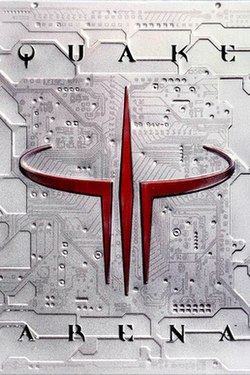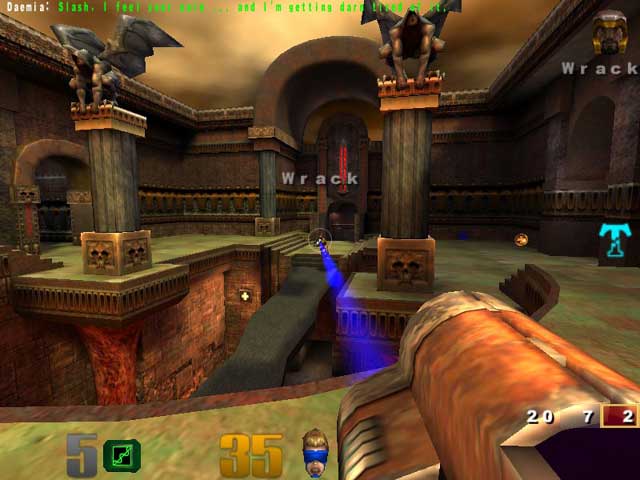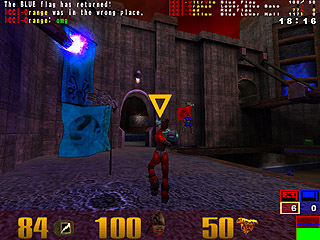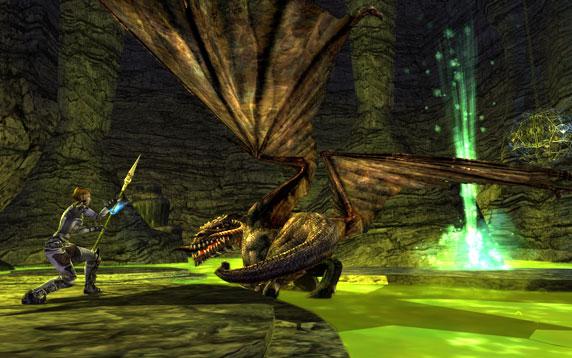Wednesday, September 22, 2010
Game Type Versus Genre
To me, a description of the player's in-game perspective is required for a good game type definition. Yet, according to Ms. Grace's article, the Call of Duty game type is nothing more than "Action". Hardly an adequate game type description for that, or any game for that matter. A better game type description would be "First Person Shooter". Add to it the the Genre and we have a perfect overall game description for Call of Duty: a "First Person War Shooter".
Monday, September 20, 2010
Final Project: Promotional Video
This short trailer explains the primary concept behind a board game entitled "Tactical Advantage," currently being developed by Jon Daley, Bobby Lee, Mike Gossett, and Adrian Palmer as a part of the curriculum for the Game Design Class at Central Piedmont Community College in Charlotte, North Carolina.
Saturday, September 18, 2010
Free Play

Fraxy is a top-down space shooter in the tradition of Asteroids but instead of shooting inbound asteroids in space, you battle crazy shaped enemy ships which shoot various types of laser weapons in a flattened 3 dimensional grid.
Was the game a challenge, fun, entertaining? Why?
- Yes, because of the cool kaleidescope type enemy ships which come in lots of different shapes and shoot cool laser beams. Instead of being in space, like asteroids, you are in a Matrix like grid.
Does the game have replay value?
- This game has limited replay value because it main task (shooting crazy looking spaceships) becomes repetitive relatively quickly. I may play it 5-7 more times at most and I don't see myself wanting to ever play it for more than 15-20 minutes at a time.
Is this game story driven or game play driven?
- Gameplay driven, there is no story. It's just a space shooter like asteroids, except the asteroids shoot back.
How is the game's presentation?
- The graphics are pretty cool, but it has no sound, at least none that I could hear. The game is played on 3d looking grid, but the gameplay is 2d
How are the Controls? Describe the Game's Feel
- At first I was using the default controls and found it awkward to play. However, after switching to the my preferred W-S-A-D configuration the game became quite nimble.
Any other special features you enjoyed?
- Nothing special, just a space shooter. Like asteroids on steroids.
On a scale of 1-10 how would you rate the game? Why?
- I'll judge it for what it is, a really cool, mildly addictive little shooter that is easy to play and has cool and unique graphics. I give it 7 Shiny Fireflies.
Thursday, September 16, 2010
Chapter Two Book Work:
 |
SSX 3 is the 3rd installment of the (BAD ASS) SSX snowboarding game series (SSX Blur not withstanding). This is a 3rd person snowboard game that seems to have been built to emphasize it's snowboarding simulation technology. The graphics and the music are all really cool and so are the tricks and combos, but the snowboard simulation experience itself is the core of what makes the game so much fun. I prefer riding the SSX snowboard engine to that of any other snowboard game I've tried. It's super-uber! |
 |
Klonoa: Door to Phontomile is a 3rd person adventure-fantasy game that I suspect was built with an emphasis on gameplay. While it does have a prominent storyline with lots of surreal Japanese-style cut scenes, Klonoa has so many different game modes and gameplay mechanics, that gameplay seems likely to be its cornerstone. On the other hand, Klonoa also seems like the kind of game that could be based on a sandbox design. This is where developers come up with a cool game technology that can do a bunch of cool things first, and then they use it to create a game. |
 |
Next up, HALO 3 (because HALO Reach hasn't arrived yet!). I suspect the entire HALO series is simply about First Person gameplay and being the first company to bring it en mass to console. Some consider the Halo series to be the DOOM\Quake of the console world. Before HALO, consoles didn't have too much in the line of FPS shooters. While there were tactical shooters for the PS2, Halo was the first game that really brought that PC-esque deathmatch kind of feel to the forefront of console games. |
High Concept: War Zone
Overview
War Zone is a 2 to 4 player board game that hinges on strategy and gathering resources. During the game players must navigate their forces through different types of terrain while trying to capture enemy troops and equipment, as well as control strategic points around the game board. The objective of the game is to out maneuver your enemies, capture their forces, and gather the most resources. When all of your resources and assets are gone you have lost; be the last player left standing and victory is yours.
Features
War Zone’s game board is dynamic in that the surface of the board can be changed from game to game. This is accomplished by having modular pieces constructing the board, each piece representing a different type of terrain. The board also features a space for each player’s Main Base, and strategic spaces that players attempt to occupy for control of additional resources.
The different types of terrain on the game board heavily factor into game play; each terrain uniquely affects not only how players can move their assets around the board, but also the minimum distance required to attack enemies. For instance, the Forrest terrain takes away from both a player’s movement and attack range because of the many obstacles that exist in that kind of terrain.
In addition to different types of terrain to navigate, players have access to different types of assets to make up their army. Each type of asset has unique attributes for movement and attack: Infantry has a high movement range but a limited attack range; Tanks have both medium movement and attack range; And Missile Batteries have very limited movement range, but the highest attack range.
Basic Gameplay
Instead of destroying an opponent’s army, players attack and capture assets from opponents by defeating them in battle. The victor can then use the captured assets as their own. Another feature is the ability to hold another player’s defeated Infantry units for ransom, with the option of selling them back to the defeated player during their next turn.
The game is designed to be played in about one hour, but could go on much longer. If the game must be ended before its natural conclusion, the winner is the player with the highest combined number of resources and assets.
Wednesday, September 15, 2010
Game Play and Control



Monday, September 6, 2010
Game Design Document
A game design document may not be necessary for very small-scale, self-funded programs being written by one or two developers. However, for larger projects requiring funding from outside sources, game design documents are a must. Rather than just some interesting idea blurted out at a pitch meeting, the design doc shows the potential investor that the game has been thought out in detail. This indicates a level of seriousness, forethought, and planning that banks and investors really like to see.
Yet, more important than the financial aspects, a game design document forces the game's designers to flush out all the details of the project at all levels. This is an effective way to make sure that no design elements get taken for granted. While parts of it will likely change throughout the development process, once written, a design document functions as a blueprint, a task list, and perhaps most importantly, a reference point for all levels of function and detail.
As one of those programmers who likes to dream it up and start coding, I dislike administrative "paperwork" as much as anyone (that in itself is an understatement). However, I've coded myself into enough corners and had enough late-term design "misunderstandings" with project managers to appreciate any tool that can reduce these unpleasant situations. It's my opinion that a well written game design document can all but eliminate them.
Saturday, September 4, 2010
Blog Game Review

As a D&D fan, I've been looking for a legitimate excuse to take the time to download and play "Dungeons and Dragons online Eberron Unlimited". What better excuse than a class assignment?
DDO is a third-person, "over-the-shoulder" MMORPG. It's free to download and try out for 30 days at www.DDO.com, after which, a $14.95 monthly is required to continue playing. The game uses the standard Advanced D&D character generation and classification model. The first time you play you must create the character and select it's gender, class, race and alignment. Next, you can personalize your character's hair, eyes, lips, nose and skin color. Once that's done, you are given the choice of which world you want to play in. I chose "Thelanis". For no other reason than it was at the top of the list.
In "Thelanis" you awake on a beach wearing nothing but robes. Off shore you see a wrecked, sinking sailing ship. You quickly meet and befriend a shifty Rouge name Jeetz. He tells you that you were a survivor of the shipwreck. The ship, he says, was attacked and sunk by a Dragon. He then offers you a sword in exchange for a favor. You accept and from there you begin your first, albeit small, quest.

While the controls are programmable to the user's liking, I used the default keyboard and mouse controls: W - Forward, S - Backwards, A - Turn Left, D - Turn Right. The space bar makes you jump. The mouse look controls looking left and right, however, in order to look up or down, you have to either hold down the right mouse button or press the "T" key on the keyboard. I found this to be cumbersome. Finally, to talk to another character, pick up on object or attack an enemy, you left-click mouse on it. Initially I found this to bee a little tricky. Not being used to the controls, I was having a bit of trouble getting my character in position to attack the enemy. Often I would be in range of the enemy, but not facing it; or, facing it, but not in range. As with any game, it can take a little while to get used to get used to the controls. After about 45 minutes, I had become much more proficient at attacking my foes correctly the first time. Yet, still, the controls never exactly felt comfortable. Accessing the various menu and inventory screens was simple enough and pretty much what you would expect from a game in this genre.

When downloading the game (from www.ddo.com), I was given a choice between the "Ultra-high Resolution" graphics package or the or "Standard Resolution" graphics package. Ever the optimist, I chose the "Ultra-High Res" package. Surely my purely pedestrian $450 Acer could handle some fancy online RPG textures. ... Right? Sadly, in order to get the game to run at even tolerable frame rates, I had to back down three full steps from "Ultra-High Resolution" to the lowly "Medium Resolution". I can honestly say the graphics on "Medium Resolution" are easily as inspiring as a bowl of wet flour. By comparison, Guild Wars, which features nicer looking graphics, ran many times better on my older, slower, Acer laptop at higher resolutions than I did DDO on my newer machine. Not surprisingly, I find the graphics to be the most disappointing aspect of the game.
Standard dramatic RPG music? ... Check. Player and environmental sound effects? ... Check.As far as this reviewer is concerned, unless there's something remarkably good or remarkably bad about the sound then I consider it to be average. The sound in DDO is just average.
In the end, if you're looking for a vessel that will satiate your primal D&D itch and you
aren't expecting amazing graphics or smooth, polished, player controls,
DDO will do the trick nicely. If, however, you're looking for a visually engrossing RPG with innovative game mechanics, BMW M3-like player control and a unique story, you'd better keep looking.
I rate this game 2.5 out of 5 Shiny Fireflies.
15 Minute Board Game - Dragon's Den
1. Pick your class
- Wizard +2 attack
- Knight +2 Defense
- Scout +1 Dexterity ( + one to roll for movement.)
2. If defeated by the Dragon go back to the start.
3. Roll die to determine movement.
5. If you land on a creature space you must battle.
- If two players land on the same squire they battle, higher card drawn wins.
- You draw cards to battle the monsters when you land on the squires using the cards.
- +1-4 means they get that amount added to the card amount they draw.
- If you lose in battle you lose your next turn.
